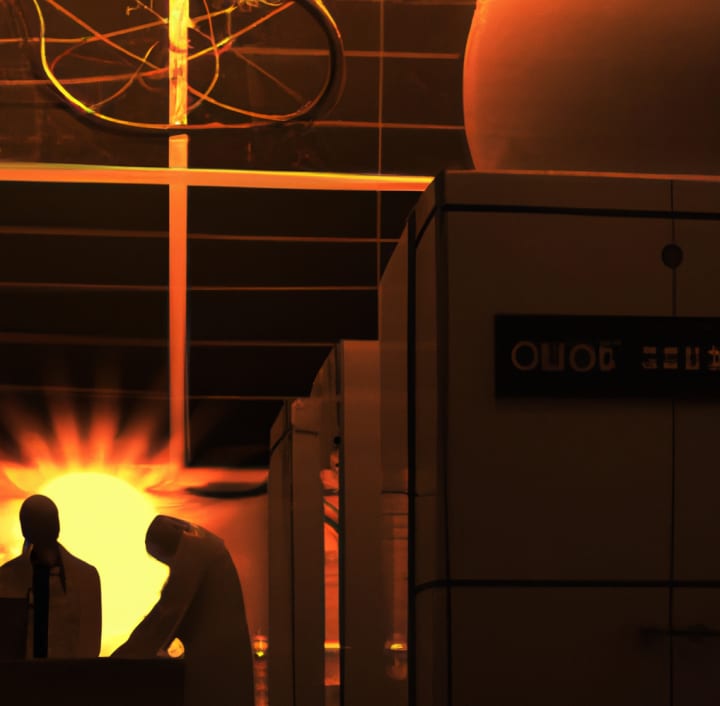There Was An Idea To Save The World
As far as initiatives go, Nick Fury's sounded better.

How does it all come to this? Well, there once was an idea so fantastic and scary that it might help to save the world. At the same time, it also sounds like something The Red Skull or some other arch-villain might do to dominate the world. Yet, it is a real idea and not something that Tony Stark and the Avengers are going to have to combat. I think we'd all feel a little better about it if Ironman was the one that pushed the idea.
Blocking Out The Sun
Many of the greatest minds believe global warming is nearing a critical juncture. We have seen the effects of global warming. The drought affecting the western part of the United States, the catastrophic wildfires around the world, and the rivers disappearing, were all examples of how climate change and global warming affect us today.
“The effects of human-caused global warming are happening now, are irreversible for people alive today, and will worsen as long as humans add greenhouse gases to the atmosphere.”
— NASA’s climate.nasa.gov/effects/
As the average temperatures continue to rise, changes to the climate pushed by increased CO2 emissions already have widespread environmental effects. The glaciers and arctic ice sheets are shrinking faster, geographic areas are shifting, and plants and trees are blooming sooner in some areas.
The world is seeing the effects predicted long ago by the scientific community. Every year humanity sees more sea ice loss, ocean level rise, and extended periods of more intense heat waves.
Enter the scientists to answer the question of what can be done to combat global warming and climate change and secure the future of our world.
Never fear, while Nick Fury is rounding up the brightest minds in the world to save Earth, he's got Hulk working on a plan.

Saving The Planet Or A Bad Idea?
Bill Gates has been funding research into solar geoengineering, a technology that aims to artificially cool the climate by reflecting sunlight into space. One of the projects he has supported is the Harvard University Solar Geoengineering Research Program investigating the feasibility and potential risks of various solar geoengineering methods.
One approach that has been proposed by the Harvard team is known as “sun dimming,” which involves injecting reflective particles into the upper atmosphere to scatter some of the sun’s rays back into space, thereby reducing the amount of heat that reaches the Earth’s surface. This idea is based on the cooling effect observed after volcanic eruptions, which also releases reflective particles into the atmosphere.
The plan to introduce particles into the atmosphere to reflect the sun remains controversial. Some have voiced concerns about the unintended and unknown consequences of radical intervention. Some fear solar geoengineering could disrupt regional weather patterns, reduce precipitation in certain areas, or even lead to international conflicts if different countries have different opinions on managing our climate.
Essentially, blocking out part of the sun’s effects on Earth is an idea going back to the 1960s, and only now, as climate mitigation efforts are straggling behind, is this controversial idea coming to the public eye.
If the sun's rays being blocked or deflected from getting to the surface of Earth sounds familiar, then you’re remembering history correctly. In this case, it’s not from a giant asteroid that the study of deflecting solar rays comes from. It’s the effects of large volcanic eruptions that have scientists theorizing they might be able to block the solar rays and lower the temperature of the planet.
After the 1991 Mount Pinatubo eruption in the Philippines, temperatures were recorded worldwide that were cooler than normal. When Mount Pinatubo erupted, it sent massive amounts of ash and gases into the stratosphere, forming a giant volcanic cloud that drifted around the globe. There were about 22 million tons of sulfur dioxide in the cloud that combined with water to form drops of sulfuric acid that blocked some of the sunlight from reaching Earth. The result is believed to be a cooling of temperatures in some areas by as much as .9 degrees Fahrenheit.
Before that, there was a similar occurrence in 1815. The Tambora Volcano in Indonesia erupted, and the resulting cloud is believed to have led to as much as a three-degree Celsius dip in global temperatures. The year after, in parts of Europe and North America, 1816 was referred to as the year with no summer.
When considering that, look at where you are today, and remember the massive eruption of Hunga Tonga-Hunga Ha’apai. To date, Hunga Tonga is the largest eruption of the 21st century and sent ash, steam, and resulting chemical compounds at least 30,000 meters into the atmosphere.
Ash Plume From Hunga Tongan Eruption

It’s clear, and reasonable to understand, that volcanic eruptions on Earth’s surface are already capable of blocking out the sun. Along with sulfur dioxide and other chemicals in a volcanic explosion, 160,900 tons of water vapor entered the stratosphere because of the Hunga Tonga eruption on January 15th, 2022. According to NASA’s Aura satellite data, water vapor and chemicals reached a maximum altitude of 33 miles, or into the mesosphere.
If it’s hard to fathom how much water that is, imagine the water from 58,000 Olympic-sized swimming pools.

Solar Geoengineering
For supporters, this offers a fix that can’t be ignored as our world heads toward “climate disaster.” Its critics, however, have a different take on the science and fear it’s so dangerous we shouldn’t even research its use. But what is solar geoengineering?
Simply put, it’s an attempt to lower the surface temperature by reflecting the sunlight away or allowing more heat to escape into space. It’s also called solar radiation management, and there are three main techniques.
- Marine cloud brightening. This process involves low-lying clouds over the seas to become more reflective by spraying them with sea salt.
- Cirrus cloud thinning. This process involves targeting the wispier clouds higher up in the atmosphere and seeding them with aerosol particles to thin them enough that they trap less heat.
- Stratospheric Aerosol Injection. This process involves spraying aerosols such as sulfur dioxide into the stratosphere, above 12 miles from the surface, to reflect the sun's rays into space.
Solar geoengineering isn’t believed to be a replacement for cutting pollution or solving the climate change crisis. However, its supporters believe it could have a cooling effect for a reasonable price. A Harvard study indicated the possibility that 2.5 billion dollars a year over 15 years could have the desired effect. That’s not that much when you consider we’ve spent enough to pay for that fifteen-year plan four to five times, helping Ukraine fight the Russians.

They want to be able to manipulate the albedo of Earth. The Earth’s albedo is determined by the amount of sunlight that is reflected into space by the atmosphere, clouds, and surface. On average, about 30% of the incoming sunlight is reflected into space, while the remaining 70% is absorbed by the Earth’s surface and atmosphere.
The albedo of the Earth can be altered by various factors, such as changes in cloud cover, snow, and ice cover, and the presence of aerosols in the atmosphere. For example, the melting of Arctic sea ice can reduce the Earth’s albedo, which can lead to more warming and melting.
Ways of Introducing Elements Into Stratosphere Without Volcanic Eruptions
Several methods have been proposed for implementing sun dimming, including aircraft-based delivery, ground-based delivery, and balloon-based delivery.
Aircraft-based delivery involves using aircraft to deliver reflective particles directly into the stratosphere. This method is considered to be the most efficient way of delivering the particles, but it is also the most expensive.
Ground-based delivery involves using tall towers or other structures to deliver the particles into the lower stratosphere. This method is less expensive than aircraft-based delivery but also less efficient.
Balloon-based delivery involves using high-altitude balloons to deliver the particles into the stratosphere. This method is less expensive than aircraft-based delivery, and it is also more precise than ground-based delivery.

"You wanna do what?"
The benefits of sun dimming include the potential to reduce global warming and the associated impacts, such as sea level rise, extreme weather events, and biodiversity loss. Sun dimming could also be a relatively inexpensive and rapid way of mitigating climate change, compared to other approaches such as reducing greenhouse gas emissions.
However, there are also several potential risks associated with sun dimming. One concern is that it could have unintended consequences, such as changes in regional weather patterns or reductions in rainfall. Another concern is that it could interfere with the Earth’s natural systems, leading to unknown and potentially harmful impacts on the environment and human health.
There are also ethical and governance issues related to sun dimming. Some experts have raised concerns that solar geoengineering could be used as a “quick fix” solution to the climate crisis. The risks are worthy of listing.
Regional Climate Changes: Sun dimming could alter regional weather patterns, leading to droughts, floods, or other climate extremes in certain areas. While it is difficult to predict how the Earth’s climate would respond to the injection of reflective particles, some computer simulations suggest that SAI could cause uneven cooling, leading to changes in rainfall patterns.
Impact on the Ozone Layer: Some of the proposed materials for sun dimming, such as sulfur dioxide, could react with other chemicals in the atmosphere and deplete the Earth’s protective ozone layer, which shields the Earth from harmful ultraviolet radiation. The depletion of the ozone layer could have harmful effects on human health and the environment.
Unknown Impacts on the Environment: There is a risk that SAI could have unintended and unforeseen impacts on the environment, including changes in ecosystems and the loss of biodiversity. The long-term effects of sun dimming on the Earth’s climate and ecosystems are not yet fully understood.
Social and Political Impacts: Sun dimming could have social and political impacts, such as changing international relations, exacerbating geopolitical conflicts, or creating ethical dilemmas. The deployment of SAI would require international cooperation and governance mechanisms to ensure that the technology is used responsibly and ethically.
Reduction in Solar Power Production: Sun dimming could reduce the amount of sunlight that reaches the Earth’s surface, which could affect the efficiency of solar power production. This could have negative economic and environmental impacts, particularly in regions that rely heavily on solar power for their energy needs.
Delaying Action on Reducing Greenhouse Gas Emissions: There is a risk that sun dimming could be seen as a “quick fix” solution to global warming, which could lead to a delay in taking action on reducing greenhouse gas emissions. While sun dimming could provide temporary relief from global warming, it does not address the root cause of the problem, which is the excessive buildup of greenhouse gases in the atmosphere.

Concluding Thoughts On Sun Dimming
One of the first things I noticed wasn’t found was the potential weaponization of technologies to control the weather. Every movie fan in the world has seen this movie, and it doesn’t play out well. We, the people of Earth, continue to ignore the obvious risks of advancement, and in the name of ensuring our survival, we destroy the world.
It does seem like a hell of a business opportunity, throwing a little bit of pixy dust into the air for 2.5 billion a year, probably with a 15-year contract signed by the current administration. In the meantime, they should be focusing on the long-term effects of the 2022 volcanic eruptions that rocked the world.
Lastly, intentionally working on dimming out the sun sounds like a bad idea. Not to point out the obvious, but after the asteroid that hit the planet and killed off the dinosaurs, didn’t they die because the sun was blocked? We can’t seem to get to a point scientifically where viruses aren’t accidentally leaked from laboratories around the world. This doesn’t seem like technology that there can be any mistakes and not risk irrevocably changing life on Earth.
With all the potential benefits sun dimming may offer us as a species, playing god might not be the right way to cure what ails Earth.
If you enjoyed my article consider leaving a like, comment, insights, or even a tip.
References:
The Effects of Climate Change, NASA, https://climate.nasa.gov/effects/
Do Volcanoes Affect Weather? USGS, https://www.usgs.gov/faqs/do-volcanoes-affect-weather
IOP Science Environmental Research Letters https://iopscience.iop.org/article/10.1088/1748-9326/aae98d/meta#acknowledgements
ScienceDirect, Earth Albedo https://www.sciencedirect.com/topics/earth-and-planetary-sciences/earth-albedo
Live Science, Tonga’s Eruption injected so much water into Earth’s Atmosphere it could weaken the ozone layer, by Harry Baker, Aug 1, 2022
CNN.com, This Controversial Climate Solution Could Be Exactly what The Planet Needs. Or It could Be A Colossal Disaster, by Laura Paddison Feb 12, 2023
About the Creator
Jason Ray Morton
I have always enjoyed writing and exploring new ideas, new beliefs, and the dreams that rattle around inside my head. I have enjoyed the current state of science, human progress, fantasy and existence and write about them when I can.






Comments (2)
https://vocal.media/earth/shivaji-maharaj-s-inspiring-story
Fascinating information. Thanks for sharing.